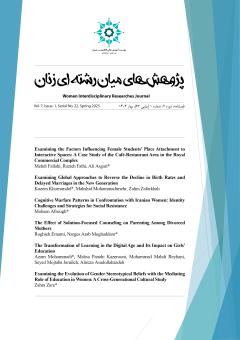The Transformation of Learning in the Digital Age and Its Impact on Girls' Education
Subject Areas :
Azam Mohammadi
1
![]() ,
Mahsa Panahi Kazerooni
2
,
Mohammad Mahdi Reyhani
3
,
Seyed Mojtaba Jamileh
4
,
Alireza Asadollahzadeh
5
,
Mahsa Panahi Kazerooni
2
,
Mohammad Mahdi Reyhani
3
,
Seyed Mojtaba Jamileh
4
,
Alireza Asadollahzadeh
5
1 - Instructor, M.A. in Social Psychology, Shahid Sharif Ashraf Elementary School, Shiraz, Fars, Iran
2 - Instructor, B.Sc., Department of Plant Protection, University of Tehran, Tehran, Iran
3 - M.Sc. in Biophysics, Department of Nuclear Medicine, Yasuj University of Medical Sciences, Imam Sajjad Hospital, Yasuj, Iran.
4 - B.Sc. in Computer Science, University of Shiraz, Shiraz, Fars, Iran
5 - B.Sc. in Business Management, Zand Non-Profit University, Shiraz, Fars, Iran.
Keywords: Digital Learning, Education in Iran, Girls, Technology Adoption in Education.,
Abstract :
The transformative trajectory of education in the Fourth Industrial Revolution underscores the crucial role of integrating technology and education. This interdisciplinary domain is characterized by active and problem-based approaches such as game-based learning, blended learning, and project-based learning, which are of particular significance in response to changes brought about by the convergence of advanced technologies. In this context, the development of digital tools and artificial intelligence has created unprecedented opportunities for enhancing personalized and interactive learning. However, the integration of information and communication technology (ICT) in developing countries, including Iran, has faced significant challenges, sparking debates regarding its impact on reducing hands-on experiences and practical engagement in educational settings. Furthermore, teachers' resistance to technological changes, financial constraints, and infrastructural limitations are among the major obstacles to this transformation. Given the increasing importance of digital educational content, this study systematically reviews the effectiveness and implementation of digital learning for girls and women. A systematic approach was employed to collect primary data, identifying 16 relevant studies. The findings indicate that digital learning positively influences girls' and women's engagement, enhances academic performance, and fosters interest in scientific subjects. Additionally, the use of blended learning methods and multimedia tools can strengthen critical thinking. However, the success of such programs requires continuous training, sustained support, and the development of flexible educational policies.
